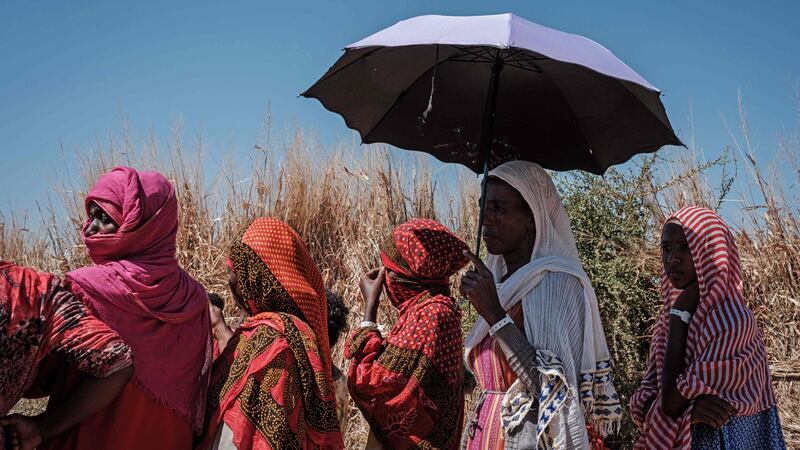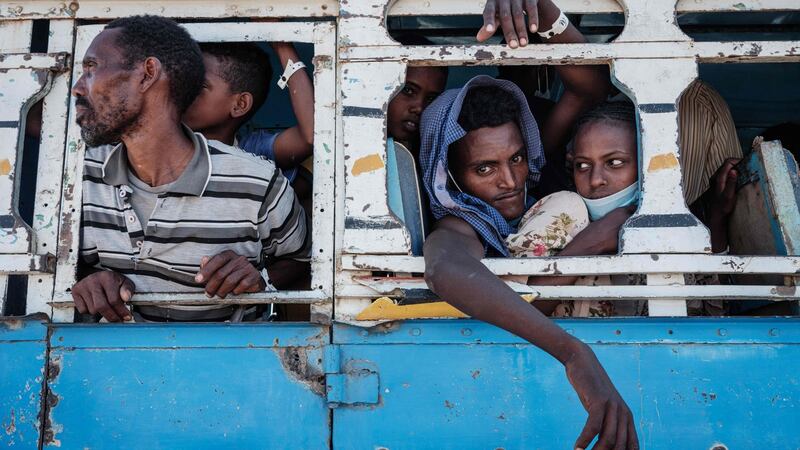Tehesh Tesfay hoped to never again see the refugee camp that sheltered her during the famine that devastated her native Ethiopia more than three decades ago. But now she is back, forced to flee her country as a brutal conflict pits prime minister Abiy Ahmed's government against rebels in the northern province of Tigray.
The 45-year-old mother is among some 50,000 refugees seeking shelter in the Um Rakuba camp and other sites just across the border in neighbouring Sudan. Tehesh said she fled vicious fighting in the Tigrayan town of Mai Kadra in the middle of the night last month, zigzagging her way through corpses and leaving her husband and daughter behind, fearing them dead.
“Some were killed with machetes, sticks, hit on the head with cobblestones,” she said as she sheltered from the sun under a makeshift tent.

Addis Ababa has been conducting a military campaign since November 4th against the Tigray People's Liberation Front (TPLF), the movement that governed Ethiopia for almost three decades until Abiy took office in 2018. Saying the offensive was a response to TPLF attacks on federal forces in the Tigrayan capital Mekelle, Abiy – who won the Nobel Peace Prize in 2019 – launched "a law enforcement" operation that included air strikes and ground troops.
Alleged massacre
The conflict quickly widened and exposed ethnic faultlines as the TPLF launched rocket attacks on the neighbouring province of Amhara. The peoples of the two regions have a history of animosity, with long-running land disputes along their shared border.
A report by human rights group Amnesty International indicated TPLF-linked militia were responsible for an alleged massacre of hundreds of Amhara in Mai Kadra last month – an allegation repeated by Abiy. Meanwhile, refugees arriving in Sudan say Tigrayan civilians were also slaughtered by Amhara militia fighting alongside the government.
The reports are difficult to verify because of a communications blackout and ban on most media entering Tigray unaccompanied. But those fleeing the violence give accounts of brutality on all sides, including by Ethiopian federal forces, Amhara special forces and irregular Amhara militias.
They say people had their throats slit, were shot in the neck, execution style, or attacked with machetes, and dogs were seen feeding on dead bodies.
At a clinic in the Sudanese border town of Hamdayet, 370km from Um Rakuba, Tigrayan student Abrahaley Menasew gingerly touched the stitches in a wound on his head as he lay on a rickety bed.
He said the injury was inflicted by an axe after he was dragged from his home in Mai Kadra by Amhara militiamen. His neck and wrist were slashed with a machete, he said, and he almost lost his hand.
“They discussed whether to kill me or take me with them, then attacked me with sticks and machetes. They left me there thinking I was dead,” said the 21-year-old. He was later found by his mother, who begged him to try and reach Sudan – two days’ walk away.
“He was very weak and frightened, he collapsed when he got here,” said Tedros Tefera, a surgeon who is a refugee from Ethiopia himself and the only doctor at the Hamdayet clinic.

Federal and Amhara officials have denied discrimination against ethnic Tigrayans. But Abrahaley alleged that even his Amhara friends told the attackers where he was because he was Tigrayan.
During the first week of the conflict some 4,000 refugees a day flocked into Sudan, forcing local authorities to reopen Um Rakuba. The camp was originally set up during the Ethiopian famine of the early 1980s in which an estimated 1m people died, the crisis that triggered a global relief effort and the Live Aid fundraising drive of Irish musician Bob Geldof. The facility was closed in the early 2000s after the end of the Eritrean-Ethiopian war.
Infiltrated
Abdelhafiz Khalil, regional co-ordinator for Sudan’s Commission for Refugees, said his country needed “great” support to cope. With 500-800 refugees still arriving each day, humanitarian agencies expect the numbers could top 100,000 in the coming months.
“We’ve not seen an influx of this scale in eastern Sudan in more than 20 years,” said Axel Bisschop, Sudan representative for the UN High Commissioner for Refugees.
Ethiopia denies any civilians have been killed in attacks by its forces and said on social media last week that the government had “credible intelligence that TPLF operatives have infiltrated refugees” in Sudan “to carry out missions of disinformation”. A senior Sudanese official said TPLF fighters have crossed the border into Sudan.
Redwan Hussein, spokesman for the government’s State of Emergency Task Force for the Tigray Crisis, told the Financial Times that the TPLF had been “on a shooting spree” and conducted machete attacks “which resulted in the death of nearly 700 non-Tigrayan civilians” in Mai Kadra.
The international community has also expressed concern over reports of dead and injured civilians after the final government offensive on Mekelle. The International Committee for the Red Cross said last week that ambulances “have been transporting injured and dead people”. Foreign diplomats in Addis Ababa told the FT that hundreds might have died in Tigray.
The government said last the weekend it had regained control of Tigray after seizing Mekelle. But Tigrayan officials say fighting is continuing in the region and analysts say the conflict may morph into a guerrilla war as fighters retreat deeper into the mountains.
– Copyright The Financial Times Limited 2020










